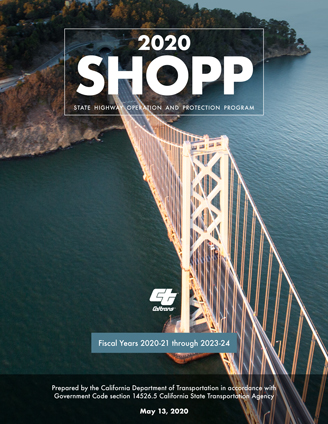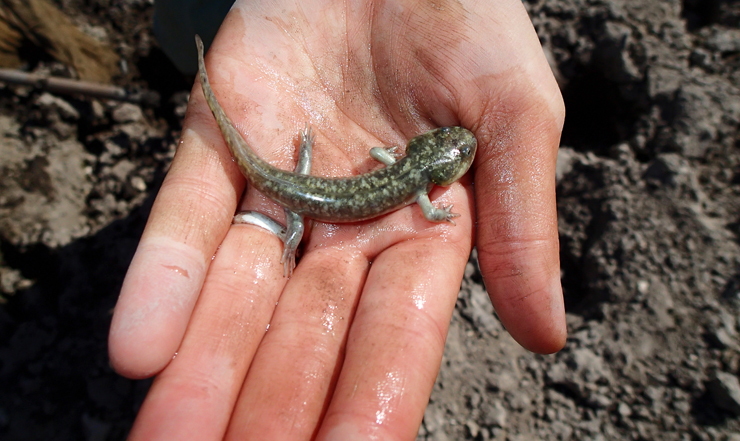Mileposts
2020-2024 SHOPP; Habitat Preservation Program; SB 743 Rules; Transportation Commission Actions

Four-Year Spending Plan for Highway System Repairs Adopted

Caltrans has won approval for its largest-ever master plan to repair and rehabilitate the state highway system for the next four years. The California Transportation Commission adopted the 2020-2024 State Highway Operations and Protection Program (SHOPP) at its May meeting, held by teleconference to comply with the state shelter-in-place order.
The $20 billion plan represents the largest investment ever made in Caltrans’ “fix-it first” fund dedicated to preservation and protection of the state-maintained road network, emergency repairs, safety upgrades and selected operational improvements.
The SHOPP proposes a slate of 920 projects through the 2023-2024 fiscal year, including 322 new projects beginning in 2020-2021 and 598 carryover projects from the previous SHOPP update in 2018. Funding comes from a mix of state and federal sources, including additional fuel taxes and vehicle registration fees generated by the Road Repair and Accountability Act of 2017 (Senate Bill 1).
An estimated $14.5 billion of the projects proposed in the 2020-2024 SHOPP will go toward infrastructure improvements of the highway system’s four major components: pavement, bridges and tunnels, transportation management system elements (such as signals, signs and sensors) and drainage systems. It’s expected that the proposed $8.8 billion in pavement spending will fix more than 5,500 lane-miles of road surface; $3.3 billion will improve about 220 bridges and tunnels, $1.5 billion will repair 3,500 TMS elements, and $900 million will upgrade more than 4,000 culverts.
The investment would make major strides toward meeting performance targets established by SB 1 for those core parts of the highway system, as well as other important components that improve safety, expand bicycle and walking opportunities, and lessen environmental impacts. Those directions are embraced in a new emphasis on “Complete Streets” projects that will remake selected state highway sections to be safer and more friendly to pedestrians, cyclists and communities.
The Commission’s action comes at a time when the state faces serious financial impacts from the COVID-19 pandemic, including an expected drop in fuel tax revenues due to less driving. How reduced revenues will affect Caltrans’ ability to fund all the projects in the four-year SHOPP has yet to be determined.
The 2020-2024 SHOPP was adopted before the Mile Marker was finalized, and its impact will be further explored in future issues.
Sources: Caltrans Asset Management program, California Transportation Commission
Advance Mitigation Program Protecting Habitat Readies for Launch

Caltrans’ Advance Mitigation Program, which aims to take a proactive approach in offsetting the environmental impacts of future transportation projects, is gearing up to becoming an integral part of the Department’s project delivery process.
In a mandated report to the state Legislature, Caltrans updated its efforts developing an Advance Mitigation Program that was created by the Road Repair and Accountability Act of 2017 (Senate Bill 1).
The program is intended to secure environmental mitigations for selected transportation projects earlier in the planning process, protecting habitat while saving time and money. SB 1 directed that $30 million be directed into an account over each of the next four years to pay for natural resource mitigation needs in advance of project impacts.
Already, $60 million has been deposited into an Advance Mitigation account from the previous two years and has not been tapped, awaiting activation of the program. Toward that end, program guidelines and a five-step planning process to approve allocations have been developed, and outreach conducted with partner agencies and stakeholders. Caltrans also is taking steps to conduct a needs assessment of affected transportation projects that encompass 11,640 acres around the state. The first round of Advance Mitigation funding for projects for review by the Caltrans director is expected in the 2020-21 fiscal year.
Caltrans Issues Proposed VMT Standards for Transportation Projects
Caltrans’ policy to phase in of use of vehicle miles traveled (VMT) as the primary metric when analyzing transportation impacts of projects on the State Highway System (SHS) is explained in the VMT CEQA Significance Determinations for State Highway System Projects Implementation Timeline Memorandum (Implementation Timing Memo) document, now posted on Caltrans’ SB 743 website.
The Project Development Transportation Analysis Framework (TAF) provides guidance for California Environmental Quality Act transportation/traffic analysis for projects on the SHS, including direction to Caltrans regional districts related to selecting methods for VMT analysis (including induced travel demand) in project-level environmental documents reflecting both project type and context (urban vs. rural).
The other guiding document, Transportation Analysis under CEQA (TAC), provides methodologies to evaluate the transportation impacts of projects on the SHS, including how to determine significance of those impacts, and will identify potential mitigation measures.
Many types of projects will not be subject to VMT as a measure of transportation impacts because they are not expected to lead to a substantial increase in vehicle travel. Those include most projects in the State Highway Operation and Protection Plan (SHOPP), Caltrans’ four-year master plan of projects involving rehabilitation, maintenance, replacement, safety, and repair work to improve the condition of existing transportation assets.
For transportation projects not on the State Highway System, local agencies have the discretion to select a different measure of transportation impact consistent with CEQA and other applicable requirements.
A target publication date for the new VMT rules is expected in advance of Sept. 15, 2020.
Source: Caltrans Office of Sustainability
New Chief Executive Leads Transportation Commission

The California Transportation Commission (CTC) has a new top administrator. Mitch Weiss was recently named executive director of the commission after having served as its deputy executive director for two years under Susan Bransen, who retired in January. The 13-member CTC is responsible for committing and allocating state and federal transportation funds as well as advising the Legislature and California State Transportation Agency on policies and plans for the state’s transportation programs.
Weiss has worked for the CTC for more than a dozen years. He led the Commission’s implementation of Senate Bill 1, an effort that included dozens of public workshops and culminated in the commitment of over $9 billion in SB 1 funds in just 13 months.
Source: California Transportation Commission
Transportation Commission Approves $2.6 Billion Multimodal Plan
The California Transportation Commission, meeting in March, approved $2.6 billion in funding for multimodal transportation improvement projects that will move people and freight more efficiently throughout the state while improving safety and the environment. The Commission also announced calls for new transportation projects totaling $2.4 billion. Nearly half the funding comes from SB 1.
The Commission conducted its regularly scheduled meeting in Sacramento via a public teleconference, in accordance with Gov. Gavin Newsom’s Executive Order on holding public meetings during the COVID-19 crisis.
The State Transportation Improvement Program (STIP) funds state highway, local road, non-motorized transportation, transit, and intercity rail improvements. The 2020 STIP makes available nearly $2.6 billion over five years. The 2020 STIP program continues funding for existing projects and also dedicates funds to more than 30 new projects across the state, including high occupancy vehicle and express lanes, commuter and intercity rail, interchange improvements, local road reconstruction and rehabilitation, bridge replacements, bicycle and pedestrian transportation improvements, zero-emission bus purchases, and more.
Source: California Transportation Commission

